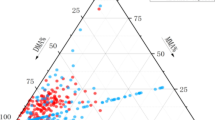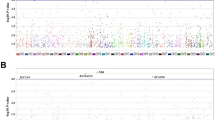Abstract
Human arsenic (+3 oxidation state) methyltransferase (AS3MT) is known to catalyze the methylation of arsenite. The objective of this study was to investigate the diversity of the AS3MT gene in Mexican and German populations. The distribution of 18 single nucleotide polymorphisms (SNPs) in AS3MT was assessed on healthy individuals: 38 Mestizo, 69 Nahuas, 50 Huicholes, and 32 Germans. All 18 SNPs were polymorphic in the German and Mexican populations. Of the three Mexican populations, a minor allele frequency was the highest in the Mestizo, followed by the Nahuas and Huicholes. In the German and three Mexican groups, haplotype #1(TATAGAAGTCTTCATGAC) was the most predominant. Seven haplotypes were newly found in the German and three Mexican populations. The D′ values between SNP pairs were high in the German and Nahua populations; they had a similar pattern. The pattern of the Mestizo was more similar to the African than to the other Mexican populations. Huicholes had a moderate pattern of the African and German/Nahua populations. The network had three clusters. One originated in the African population and another may have originated in an Asian (Chinese and/or Japanese) population. The third one may have originated among Caucasians. This study is the first to demonstrate the existence of genetic heterogeneity in the distribution of 18 SNPs in AS3MT of German and Mexican populations.



Similar content being viewed by others
References
ATSDR (2006) Arsenic. Chemical agent briefing sheet. Available: http://www.atsdr.cdc.gov/cabs/arsenic/index.html#effect
Cebrián ME et al (1994) Chronic arsenic poisoning in humans. The case of Mexico. In: Niriagu JO (ed) Arsenic in the environment. part II: human health and ecosystem effects. Wiley, New York, pp 93–107
Fujihara J, Kunito T, Agusa T, Yasuda T, Iida R, Takeshita H (2007a) Population differences in the human arsenic methyltransferase (AS3MT) gene polymorphism detected by using genotyping method. Toxicol Appl Pharmacol 225:251–254
Fujihara J, kunito T, Takeshita H (2007b) Frequency of two human glutathione-S-transferase omega 1 polymorphisms (E155 deletion and E208 K) in Ovambo and Japanese populations using the PCR-based genotyping method. Clin Chem Lab Med 45:621–624
Fujihara J, Fujii Y, Agusa T, Kunito T, Yasuda T, Takeshita H (2009) Ethnic differences in five intronic polymorphisms associated with arsenic metabolism within human arsenic (+3 oxidation state) methyltransferase (AS3MT) gene. Toxicol Appl Pharmacol 234:41–46
Fujihara J, Fujii Y, Agusa T, Kunito T, Yasuda T, Takeshita H (2010) Global analysis of genetic variation in human arsenic (+3 oxidation state) methyltransferase (AS3MT). Toxicol Appl Pharmacol 243:292–299
Hernández A, Xamena N, Surrallés J, Sekaran C, Tokunaga H, Quinteros D, Amadeu Creus A, Marcos R (2008a) Role of the Met 287 Thr polymorphism in the AS3MT gene on the metabolic arsenic profile. Mutat Res 637:80–92
Hernández A, Xamena N, Sekaran C, Tokunaga H, Sampayo-Reyes A, Quinteros D, Amadeu Creus A, Marcos R (2008b) High arsenic metabolic efficiency in AS3MT287Thr allele carriers. Pharmacogenet Genomics 18:349–355
IARC (1980) Some metals and metallic compounds. IARC monographs on the evaluation of the carcinogenic risk to humans, vol. 23. IARC, Lyon, France, pp 39–141
Lin S, Shi Q, Nix FB, Styblo M, Beck MA, Herbin-Davis KM, Hall LL, Simeonsson JB, Thomas DJ (2002) A novel S-adenosyl-L-methionine: arsenic (III) methyltransferase from rat liver cytosol. J Biol Chem 277:10795–10803
Lindberg AL, Kumar R, Goessler W, Thirumaran R, Gurzau E, Koppova K, Rudnai P, Leonardi G, Fletcher T, Vahter M (2007) Metabolism of low-dose inorganic arsenic in a central European population: influence of sex and genetic polymorphisms. Environ Health Perspect 115:1081–1086
Marnell LL, Garcia-Vargas GG, Chowdhury UK, Zakharyan RA, Walsh B, Avram MD (2003) Polymorphism in the human monomethylarsonic acid (mmav) reductase/hgsto1 gene and changes in urinary arsenic profiles. Chem Res Toxicol 16:1507–1513
Meza MM, Yu L, Rodriguez YY, Guild M, Thompson D, Gandolfi AJ, Klimecki WT (2005) Developmentally restricted genetic determinants of human arsenic metabolism: association between urinary methylated arsenic and CYT19 polymorphism in children. Environ Health Perspect 113:775–781
Meza MM, Gandolfi AJ, Klimecki WT (2007) Developmental and genetic modulation of arsenic biotransformation: A gene by environmental interaction. Toxicol Appl Pharmacol 222:381–387
Navas-Acien A, Silbergeld EK, Pastor-Barriuso R, Guallar E (2008) Arsenic exposure and prevalence of type 2 diabetes in US adults. JAMA 300:814–822
NRC (1999) Arsenic in drinking water. National academy press, Washington, DC
Rossman TG (2003) Mechanism of arsenic carcinogenesis: an integrated approach. Mutat Res 533:37–65
Schläwicke Engström KS, Broberg K, Concha G, Nermell B, Warholm M (2007) Genetic polymorphisms influencing arsenic metabolism: evidence from Argentina. Environ Health Perspect 115:599–605
Stephens M, Donelly PA (2003) Comparison of bayesian methods for haplotype reconstruction from population genotype data. Am J Hum Genet 273:1162–1169
Vahter M (2000) Genetic polymorphism in the biotransformation of inorganic and its role in toxicity. Toxicol Lett 112–113:209–217
Vahter M (2002) Mechanisms of arsenic biotransformation. Toxicology 181–182:211–217
Valenzuela OL, Drobná Z, Hernández-Castellanos E, Sánchez-Peña LC, García-Vargas GG, Borja-Aburto VH, Stýblo M, Del Razo LM (2009) Association of AS3MT polymorphisms and the risk of premalignant arsenic skin lesions. Toxicol Appl Pharmacol 239:200–207
Whitbread AK, Tetlow N, Eyre HJ, Sutherland GR, Board PG (2003) Characterization of the human omega class glutathione transferase genes and associated polymorphisms. Pharmacogenetics 13:131–144
Acknowledgments
This work was partially supported by Grants-in-Aid from the Japan Society for the Promotion of Science (19209025 and 21659175 to H. Takeshita and 21590736 to J. Fujihara).
Author information
Authors and Affiliations
Corresponding author
Electronic supplementary material
Rights and permissions
About this article
Cite this article
Fujihara, J., Yasuda, T., Kato, H. et al. Genetic variants associated with arsenic metabolism within human arsenic (+3 oxidation state) methyltransferase show wide variation across multiple populations. Arch Toxicol 85, 119–125 (2011). https://doi.org/10.1007/s00204-010-0568-y
Received:
Accepted:
Published:
Issue Date:
DOI: https://doi.org/10.1007/s00204-010-0568-y




